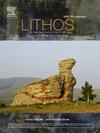Protolith age, and timing of burial and exhumation of the UHP Chasteiran Unit (Dora-Maira Massif, Western Alps), constrained by zircon, garnet and rutile petrochronology
IF 2.9
2区 地球科学
Q2 GEOCHEMISTRY & GEOPHYSICS
引用次数: 0
Abstract
The Chasteiran Unit in the northern Dora-Maira Massif reached ultra-high-pressure conditions in the chloritoid-coesite stability field. The chemical and isotopic behaviours of zircon, garnet, and rutile from a metapelite were explored to reconstruct the metamorphic evolution of this Unit.
Zircon crystals display detrital cores and thin (< 5 μm) metamorphic rims which cannot be dated. The dominant zircon population consists of Late Neoproterozoic (⁓600 Ma) magmatic grains whereas the youngest zircon cluster is Ordovician in age (⁓470 Ma).
Garnet records three main growth stages: initial growth during a prograde pressure and temperature increase in the quartz stability field (2.5–2.7 GPa at 470–500 °C, inner core – stage 1), peak growth in the coesite stability field (2.7–2.8 GPa at 510–530 °C, outer core – stage 2), and final growth of the garnet rim between 2.3 GPa 520 °C and 1.5 GPa 510 °C (stage 3), contemporaneously with lawsonite consumption coupled with fluid production.
LA-ICP-MS U-Pb dating of garnet indicates two distinct stages of growth for garnet cores and rims at ⁓61 Ma and ⁓43 Ma, respectively. The time interval separating the growth of garnet cores and rims is consistent with our thermodynamic modelling, which indicates the absence of garnet growth during the initial stage of exhumation, between 2.7. GPa and 2.3 GPa.
Rutile is found both as inclusions in garnet and in the matrix. Rare inclusions of jadeite and Si-rich muscovite also indicate stability of rutile during burial at a minimum pressure of 2.0 GPa. Inclusions of rutile in garnet are commonly surrounded by fractures and some crystals display ilmenite exsolution lamellae, suggesting that despite their mode of occurrence, they might have behaved as an open system during retrograde metamorphism. Rutile consumption took place during exhumation, as suggested by the increase in Ti content in garnet and muscovite rims and thermodynamic modelling. Rutile in the matrix is partially replaced by ilmenite corona, which developed at P < 1.5 GPa, after garnet growth. SIMS U-Pb dating of rutile, irrespective of its petrographic mode of occurrence, yields a date of ⁓37 Ma.
Our geochronological data suggest a different timing of burial and exhumation for the northern and southern Dora-Maira Massif and imply that the peak ultra-high-pressure episode in the northern Dora-Maira Massif is older than the peak eclogite-facies in the overlying oceanic units. Therefore, different extensional allochthons derived from the Briançonnais hyperextended palaeomargin may have been buried and/or detached from the downgoing slab at different times.
求助全文
约1分钟内获得全文
求助全文
来源期刊

Lithos
地学-地球化学与地球物理
CiteScore
6.80
自引率
11.40%
发文量
286
审稿时长
3.5 months
期刊介绍:
Lithos publishes original research papers on the petrology, geochemistry and petrogenesis of igneous and metamorphic rocks. Papers on mineralogy/mineral physics related to petrology and petrogenetic problems are also welcomed.
 求助内容:
求助内容: 应助结果提醒方式:
应助结果提醒方式:


